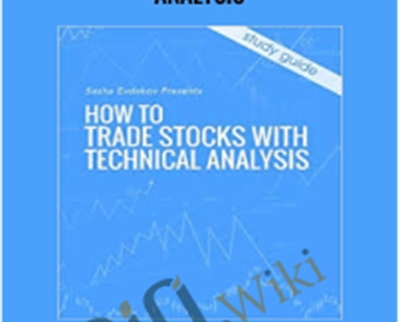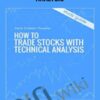$649.00 Original price was: $649.00.$121.00Current price is: $121.00.
Learn in-depth technical analysis techniques so that you can forecast a stock movement & behavior with Trading with Technical Analysis
This course is recommended for people who have good basics about the stock market and have been studying the markets for a year or more. Although the contents and presentation of this course are suited for a beginner to understand, you should be an enthusiastic and passionate learner as this course is extremely in-depth and requires multiple hours of study.
 Purchase this course you will earn 121 Points worth of $12.10
Purchase this course you will earn 121 Points worth of $12.10Elevate your skills with the Trade stocks with technical analysis – Sasha Evdakov course, available for just $649.00 Original price was: $649.00.$121.00Current price is: $121.00. on Utralist.com! Browse our curated selection of over 60,000 downloadable digital courses across diverse Uncategorized. Benefit from expert-led, self-paced instruction and save over 80%. Start learning smarter today!
Overview of the Technical Analysis Course
See a detailed breakdown of each video and what you will learn
(DVD 1) Module 1: Introduction
Run time: 51 minutes
In the first video you will learn the foundation and basics to getting the most from this course. We will start convering a general overview of analysis and what to focus on as you study the material. You will learn:
- Tips, ideas, and techniques of how you can be more successful in this course
- Key important things you should watch when reading technical analysis
- Common obstacles for most people just starting to trade and tips on how you can overcome these obstacles
- A general overview of fundamental analysis and technical analysis why you want to focus on the technicals
- What I focus on as I evaluate a stock prior to taking a trade
- What I ignore and don't care about when I trade stocks
(DVD 2) Module 2: Technical Basics
Run time: 34 minutes
In this video you will learn the technical basics. Before you can read technical analysis or apply it to your trading, you have to know what it is all about and how you can use it. You will learn:
- What is technical analysis all about and why is it important
- Why you should use technical analysis to make a majority of your trading decisions
- Understanding cycles and how stocks move in repeatable cycles that gives you an advantage to predict
- How to evaluate a stock on multiple time-frames
- A common phrase you should remember when looking at stock charts that will stick with you for life
- 3 key points to remember about technical analysis
(DVD 3) Module 3: Charting Basics
Run time: 43 minutes
Charting basics is about getting the right foundation to reading and evaluating stock charts. There are a variety of ways you can look at charts from the types of charts to various time frames. You will learn:
- What are candlesticks and why you should learn about them
- Different types of charts that you can look at when trading off the charts
- The difference between arithmetic and logarithmic charts and which one you should use
- Critical questions you should ask yourself when looking at charts
- Why you must look at different chart-time frames before taking a trade
- What are trends and the significance of trends
- 3 different types of trends in stocks and which one to focus on when trading
- What a violation of a trend will tell you about a stock
(DVD 4) Module 4: Candlesticks
Run time: 31 minutes
In this video you will learn about the important candlestick patterns to watch for when looking at stock charts. By learning about a few major candlestick patterns, you will learn how a stock is moving for that time period, and you will know when a stock may change momentum or direction. You will learn:
- What are engulfing patterns and why you should watch for them
- What are hammers and hanging men
- What are shooting stars, what they look like, and why you should scan for them
- Four different types of dojis and what they represent on the chart
(DVD 5) Module 5: Volume
Run time: 64 minutes
In this module you will learn how volume is the critical leading indicator to watch when trading stocks. Volume is the fuel that moves the stocks. Without knowing or understanding quality volume, you won't know if your stock move is real. In this module you will learn:
- What is volume and why it is so important
- What volume tells you when it is increasing or decreasing
- How to read quality volume and stop high-value trades
- What you should be watching when strong volume breaks out
- How you can calculate intraday volume to spot high volume signals during the day
- Four phases a stock goes through and repeats
- Five different volume chart patterns to look for and what they mean
- A volume training exercise you can do to practice your volume reading skills
(DVD 6) Module 6 & 7: Cause & Effect + Swing Points
Run time Module 6: 30 minutes | Module 7: 27 minutes
In module 6 we focus on cause and effect and how it applies to stocks. Cause and effect applies to all aspects of life – not just stocks. We discuss energy and what is the cause and effect in stocks. In module 7 we discuss swing points in stocks along with ABCD patterns and how you can use them to setup a trade. In these two modules you will learn:
- What is cause and effect and how it applies to stocks.
- How to look at the energy of the stocks and what it means to the movement
- How wide price spread is the effect in stocks and how it confirms the move
- What are swing points and why it is invaluable to understand them
- The basics of ABCD patterns and what to expect from each leg
- How the volume should act & behave when looking at breaks in the swing points
(DVD 7) Module 8 & 9: Support & Resistance + Confluence
Run time Module 8: 31 minutes | Module 9 Run time: 20 minutes
In module 8 you will learn about support and resistance and how watching certain levels in a stock will allow you project areas where a stock may bounce or power higher. In module 9 we focus on confluence which is about understanding areas or points where a stock comes together. Think of confluence as a point wh ere buyers and sellers meet – it is this area that could show you mixed signals and throw you off your game. In these modules you will learn:
- What is support and resistance
- Examples of various support and resistance lines
- How resistance lines can become support lines and vice-versa
- What is confluence and how it applies to stocks
- How confluence tricks traders with their entries and exit points
- How much confluence to expect in stocks at various price levels
(DVD 8) Module 10: Trend Lines & Channels
Run time: 37 minutes
In this video you will learn about trend lines and a more in-depth look at support and resistance using trend lines. We will also cover channels and how a tight channel can ultimately give a stock more importance when it comes to support and resistance. You will also learn:
- What are trend lines and when to enter a stock if a trend line breaks
- What is the trend line fan principle and how to apply it on charts
- What is a healthy trend line angle and why it's important to watch
- What are channels and why you should watch them in determining your projected move
- Different types of channels that you may find in stocks
(DVD 9) Module 11: Retracements
Run time: 44 minutes
We know that stocks don't go up forever, nor do they move up in a straight line. In this module we talk about retracements. The right retracements are healthy in a stock and knowing what is a healthy retracement or a fake retracement will give you more confidence on pull backs. If you know whats a healthy retracement, then you will know areas of support, resistance, and opportunities of where you can purchase the stock on a bounce. In this module you will learn:
- How most people think stocks move and how they really move
- What a healthy retracement looks like in stocks and what to watch for
- Why I love pull backs and retracements and you should too
- What is Fibonacci and how to use it in your retracement levels
- What are the important Fibonacci levels to watch in stocks
- How to calculate Fibonacci levels in your stock retracements
- How to calculate expansion levels in a stock move
(DVD 10) Module 12: Gaps
Run time: 23 minutes
Gaps occur frequently in stocks if you watch the markets closely. It is important to recognize gaps in a stock in not only that there is a gap, but how big of a gap the stock created, when it created it, and what can happen when a stock you're watching gaps up or down. In this video you will learn:
- What are gaps in a stock
- Why gaps are important in a stock and why you should watch them
- Why the distance and space the gap creates is important
- How gaps can create support and resistance areas
- Why gaps typically get filled and what it means for the stock
- Why sometimes gaps do not get filled
- What are the three types of gaps and when do they occur
(DVD 11) Module 13: Reversal Patterns
Module 13 Run time: 56 minutes
Reversal patterns are key signals in a chart that develop prior to a stock changing its direction. Reversal patterns give you clues and signals of when a potential trend could be over. In this video you will learn:
- What are chart patterns and the two primary chart patterns stocks have
- What you should focus on when you watch chart patterns
- How the head and shoulders pattern is constructed
- When you should enter or exit the head and shoulders pattern
- How to forecast and project the movement on the head & shoulders pattern
- The triple top and bottom patterns and what to watch for on the break of the pattern
- How double tops and bottoms are created and when you should enter these patterns
- How to identify false breakouts on the double top and double bottom patterns
(DVD 12) Module 14: Continuation Patterns
Module 14 Run time: 66 minutes
Continuation patterns are healthy movements in a stock that give it a pause (or breathing room) right before the stock continues moving in the same direction as it was heading before. When you know how to spot continuation patterns, they will create opportunities for you to add to your position so that you can make the most out of the trade. In this lesson you will learn:
- What are continuation patterns
- What is the difference between continuation and reversal patterns
- Three types of triangle patterns and when to enter the trade
- How to calculate a projected move on a triangle pattern
- What does a flag pattern look like and when you should enter the trade
- How to spot a pennant pattern and when is the right time to pull the buy trigger
- What are the right volume signals on flag and pennant pattern
- What a trading range looks like and when to enter the stock
- What is a cup and handle pattern and how to trade it
(DVD 13) Module 15 & 16: Moving Averages + Oscillators
Run time Module 15: 27 minutes | Module 16: 23 minutes
In module 15 you will learn about moving averages and how you they can give you a cleaner picture to a stock's movement if you are having trouble figuring it out. You will also learn a few ways to trade just off the moving averages. In module 16 we will cover the basics of oscillators. Oscillators are usually better suited to use as exit signals and in this module you will learn about some common oscillators and how you can use them. You will learn:
- The basics of moving averages and what they are
- Popular moving averages that many traders scan and watch
- Different types of moving averages that you can use in your trading
- How to use the double crossover method in moving averages
- What are oscillators and when you should use them
- What are some popular oscillators and the basics of how to use them
(DVD 14) Module 17: Putting Your Analysis into Action
Run time: 28 minutes
The final module is about wrapping things up and putting things together. You will get some final tips about trading, some ideas of what you should think about prior to executing a trade, and some final insight. Topics we cover in this video include:
- A basics game plan that you should think about before trading
- What company specific data you should look at before entering a trade
- A few final general tips on trading
- A list of resources that you can use to continue your training
- The next steps you should take with your trading and what you can do to continue to improve
Tag: Trade stocks with technical analysis – Sasha Evdakov Review. Trade stocks with technical analysis – Sasha Evdakov download. Trade stocks with technical analysis – Sasha Evdakov discount.
Cultivate continuous growth with the Trade stocks with technical analysis – Sasha Evdakov course at Utralist.com! Unlock lifetime access to premium digital content, meticulously designed for both career advancement and personal enrichment.
- Lifetime Access: Enjoy limitless access to your purchased courses.
- Exceptional Value: Benefit from savings up to 80% on high-quality courses.
- Secure Transactions: Your payments are always safe and protected.
- Practical Application: Gain real-world skills applicable to your goals.
- Instant Accessibility: Begin your learning journey immediately after buying.
- Device Compatible: Access your courses seamlessly on any device.
Transform your potential with Utralist.com!
Related products
= 125 Points
Uncategorized
= 35 Points
Uncategorized
= 30 Points
Uncategorized
= 95 Points
= 125 Points
= 65 Points
Uncategorized
Disordered Eating Behaviors: Identify and Treat the Underlying Trauma – Lori Kucharski
= 85 Points
Uncategorized
= 85 Points





